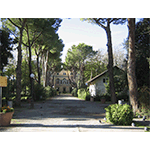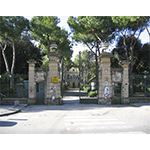Biblioteca Comunale Labronica "Francesco Domenico Guerrazzi" ["Francesco Domenico Guerrazzi" Municipal Library of Livorno]
The origins of the Library of Livorno, or "Biblioteca Labronica" (from the Latin Labro, -onis, the port reported by Cicero and perhaps in the vicinity of Castiglioncello) are tied to the homonymous academy instituted by Giuseppe Vivoli in 1816 with the approval of Grand Duke Ferdinand III of Lorraine. The Academy purposed to promote the sciences, letters and the arts. It ceased activity in the last decade of the 19th century.
It was precisely by initiative of the first members of the Labronica Academy that the library was founded and the "Minutes" were published. In 1840, the Library already counted 7000 volumes and, three years later, given the considerable increase of its book holding, it opened to the public four days a week. In 1852, the academicians donated the Library to the Municipality, which increased its book holding with purchases, gifts and acquisitions of collections both private and of the suppressed religious institutions, including the library of Livornese republican and writer Francesco Domenico Guerrazzi.
Alongside numerous collections of autographs and manuscripts, including the famous Ugo Foscolo collection, the library conserves more than 600 volumes printed in Livorno between 1644 and 1900. Among the first editions of great value, worthy of mention under the technical and scientific profile is the Livorno edition of the Encyclopédie by Diderot and d’Alembert (1770-1779). Particularly important is also the Collection of the Bastogi family heirs (from count Pietro Bastogi and his son Gioacchino, both bibliophiles and collectors of autographs), consisting in 54,600 manuscripts (16th - 19th century), including many autographs. Among major figures, in addition to the men of letters Giacomo Leopardi and Gabriele D’Annunzio, let us also mention the scientist Galileo Galilei.
In addition to the Labronica Academy, Livorno has also numbered other scientific assemblies. Instituted in 1751 by Filippo Venuti, the main purpose of the Venutiana Academy was to promote and give diffusion to natural history, the sciences of antiquity and other learned themes. This "colony" of the Colombaria Academy of Florence met at Venuti’s home in sessions called "Labronic Nights", memory of which is conserved in Curiosità Livornesi by Francesco Pera. The Academy was short-lived, considering that after only three years, its meetings ceased in 1754. Later, Venuti was also the promoter of the Academy of the Curious about Nature, which in name and programmatic aims, was inspired by the old homonymous Academy founded in Germany in 1652 by J.L. Bausch, with the purpose of discussing and investigating themes of a scientific nature.
****************************
Texts by Anna Toscano
English translation by Victor Beard
Last update 21/gen/2008





